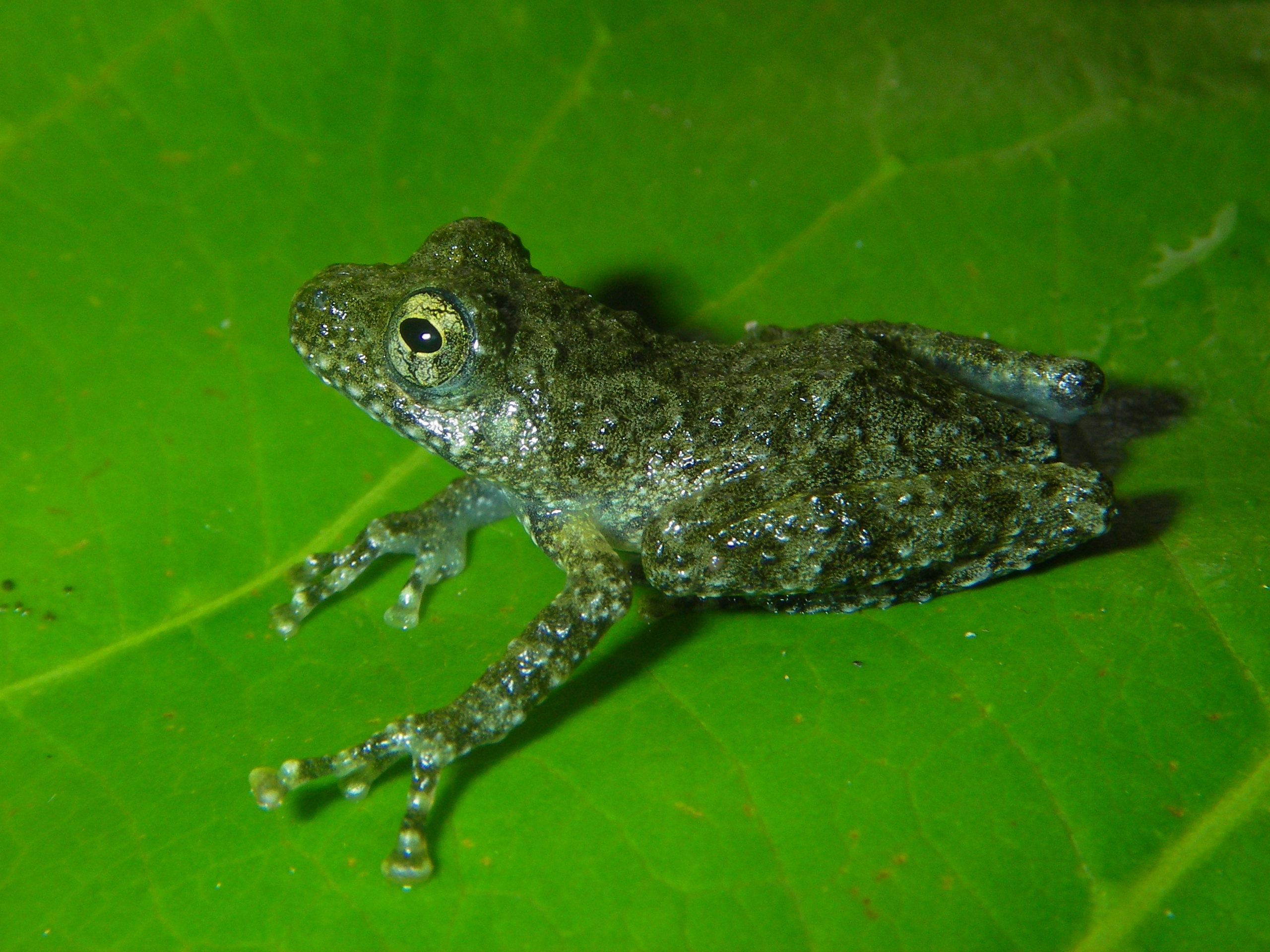| Citation |
IUCN SSC Amphibian Specialist Group, 2013. Gracixalus quyeti. The IUCN Red List of Threatened Species 2013: e.T187822A1827489. http://dx.doi.org/10.2305/IUCN.UK.2013-1.RLTS.T187822A1827489.en. Downloaded on 08 May 2019. |
Description |
Geographic Range
NATIVE
Extant (resident)
Viet Nam
Presence Uncertain
Lao Peoples Democratic Republic
NUMBER OF LOCATIONS
UPPER ELEVATION LIMIT
1,100 metres
LOWER ELEVATION LIMIT
300 metres
UPPER DEPTH LIMIT
LOWER DEPTH LIMIT
Geographic Range in detail
ESTIMATED AREA OF OCCUPANCY (AOO) (KM²)
CONTINUING DECLINE IN AREA OF OCCUPANCY (AOO)
EXTREME FLUCTUATIONS IN AREA OF OCCUPANCY (AOO)
ESTIMATED EXTENT OF OCCURRENCE (EOO) (KM²)
1379
CONTINUING DECLINE IN EXTENT OF OCCURRENCE (EOO)
EXTREME FLUCTUATIONS IN EXTENT OF OCCURRENCE (EOO)
CONTINUING DECLINE IN NUMBER OF LOCATIONS
EXTREME FLUCTUATIONS IN THE NUMBER OF LOCATIONS
RANGE DESCRIPTION
This species is known from Nuoc Rung area (1,100 m asl), Dan Hoa Commune, Minh Hoa District, and Cha Noi area (430 m asl), Phong Nha–Ke Bang National Park, both within Quang Binh Province, as well as from Rao An forest (300 m asl), Huong Son District, Ha Tinh Province (Tao Nguyen pers. comm. October 2012; Rowley et al. 2011), all in central Viet Nam (Nguyen et al. 2008). Its range, taken as a proxy for extent of occurrence (EOO) is estimated to be approximately 1,379 km2 and it is presumed to occur more widely across the central Truong Son mountain range (Truong Nguyen pers. comm. February 2011), and possibly also into Lao Peoples Democratic Republic.
Population
CURRENT POPULATION TREND
Unknown
NUMBER OF MATURE INDIVIDUALS
POPULATION SEVERELY FRAGMENTED
Yes
CONTINUING DECLINE OF MATURE INDIVIDUALS
Population in detail
EXTREME FLUCTUATIONS
NO. OF SUBPOPULATIONS
CONTINUING DECLINE IN SUBPOPULATIONS
EXTREME FLUCTUATIONS IN SUBPOPULATIONS
ALL INDIVIDUALS IN ONE SUBPOPULATION
NO. OF INDIVIDUALS IN LARGEST SUBPOPULATION
DESCRIPTION
It is considered to be rare within its known distribution range (Truong Nguyen pers. comm. August 2011), and its population is considered to be severely fragmented given that its habitat is patchy and fragmented, its dispersal capacity is believed to be low, and the entire known population is found in three small isolated habitat patches separated by large distances.
Habitat and Ecology
SYSTEM
Terrestrial, Freshwater (=Inland waters)
HABITAT TYPE
Forest, Artificial/Terrestrial
GENERATION LENGTH (YEARS)
CONGREGATORY
MOVEMENT PATTERNS
CONTINUING DECLINE IN AREA, EXTENT AND/OR QUALITY OF HABITAT
Yes
Habitat and Ecology in detail
HABITAT AND ECOLOGY
It is known from lowland and montane evergreen and karst forests (Nguyen et al. 2008; Tao Nguyen pers. comm. October 2012), including some disturbed forest in Rao An (Tao Nguyen pers. comm. October 2012). It has been found at night on shrubs leaves (1.5-2 m above ground) near small streams and limestone forests (Nguyen et al. 2008). Although a single individual has been found in disturbed forest, it is not known to what extent the species can withstand habitat disturbance. Its reproduction mode is still unknown, although it is suspected to reproduce like other congeners (egg deposition on leaves and tadpoles falling into water to complete larval development).
CLASSIFICATION SCHEME
Habitats Suitability Major importance
1. Forest 1.6. Forest - Subtropical/Tropical Moist Lowland Suitable Yes
1.9. Forest - Subtropical/Tropical Moist Montane Suitable Yes
14. Artificial/Terrestrial 14.6. Artificial/Terrestrial - Subtropical/Tropical Heavily Degraded Former Forest Marginal
Threats
Agriculture & aquaculture
Annual & perennial non-timber crops
Transportation & service corridors
Roads & railroads
Biological resource use
Gathering terrestrial plants
Logging & wood harvesting
Natural system modifications
Fire & fire suppression
Threats in detail
THREATS
Major threats to this species within the Phong Nha-Ke Bang National Park and the Nuoc Rung area are habitat loss and habitat degradation due to illegal timber logging and forest fire caused by local communities establishing cultivation (Truong Nguyen pers. comm. August 2011), whereas the major threats in Rao An forest are habitat loss and degradation due to timber logging and non-timber forest product collection (Tao Nguyen pers. comm. October 2012). Road and highway construction may also be another major threat to this species (Truong Nguyen pers. comm. August 2011).
CLASSIFICATION SCHEME
Threats Timing Stresses Scope Severity Impact score Invasive species Virus
2. Agriculture & aquaculture 2.1. Annual & perennial non-timber crops 2.1.2. Small-holder farming Ongoing
1. Ecosystem stresses 1.1. Ecosystem conversion
1.2. Ecosystem degradation
Low Impact: 3
4. Transportation & service corridors 4.1. Roads & railroads Ongoing
1. Ecosystem stresses 1.1. Ecosystem conversion
1.2. Ecosystem degradation
Low Impact: 3
5. Biological resource use 5.2. Gathering terrestrial plants 5.2.2. Unintentional effects (species is not the target) Ongoing
1. Ecosystem stresses 1.2. Ecosystem degradation
Low Impact: 3
5.3. Logging & wood harvesting 5.3.4. Unintentional effects: (large scale) [harvest] Ongoing
1. Ecosystem stresses 1.1. Ecosystem conversion
1.2. Ecosystem degradation
Low Impact: 3
7. Natural system modifications 7.1. Fire & fire suppression 7.1.1. Increase in fire frequency/intensity Ongoing
1. Ecosystem stresses 1.1. Ecosystem conversion
1.2. Ecosystem degradation |

